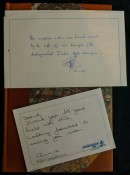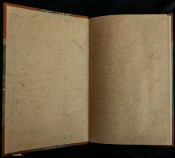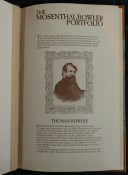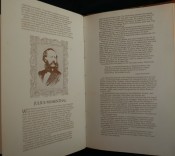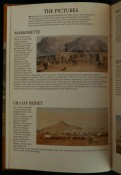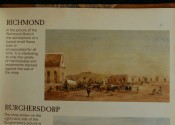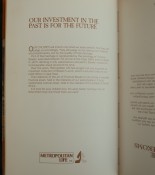Commissioned by Metropolitan Life who spared no expense in the production of this somewhat bespoke and extremely handsome publication with its half calf leather over handmade marbled board cover. Included is a note of thanks to the popular Africana authority and expert student on the works of Thomas Bowler, Frank Bradlow, for his help in compiling this volume. There is also a most interesting note signed by Bradlow noting that the marbled boards were handmade by Griet van Krimpen, the wife of Jan van Krimpen (the legendary Dutch type designer - he created 'Lutetia' among many, many other fonts).
Light random foxing in places, otherwise the contents are clean and fresh throughout.
Mosenthals: A Metaphor for the Fortunes of Port Elizabeth "For me, the firm Mosenthals epitomises both the growth and subsequent decline of Port Elizabeth, but also the trajectory of South Africa’s industrial, agricultural and commercial growth. Even my family has a connection to this once prominent company. Firstly, my maternal grandfather was a wool sorter and later my mother was a typist in their employ. Let us trace the journey that Mosenthals, Port Elizabeth and South Africa took. Central to the founding of Mosenthals was an entrepreneur of German extraction, Joseph Mosenthals. In the spirit of enterprise that drove Joseph, he had elected to leave his homeland. Whether he had any notion of establishing a company in the Cape Colony or whether he was merely on a reconnaissance mission in order to establish the potential of this far-off undeveloped land, one will never know for certain. Joseph’s business eye must have espied some business opportunities as he set himself up as Mosenthal Brothers - General Merchants in St. George’s Street in Cape Town. The plural in the word Brothers reflected the fact that Joseph had urgently requested his brother Adolph to join him in the business. Within a short period, their activities covered a wide area extending to Murraysburg, Burgersdorp, Richmond, Graaff Reinett and Hopetown. In six years, Mosenthals had become one of the leading forms of merchants in the Cape Colony. For those initial six years, Cape Town was to be the Head Quarters of the flourishing business. Then being the sharp businessmen that they undoubtedly were, these two founders perceived that as a distribution centre, Port Elizabeth would develop into a prominent town and port. Even though during the 1840s, Port Elizabeth was a diminutive in comparison to Uitenhage or Grahamstown, they had the foresight to relocate their headquarters there. Wherever the brothers cast their eyes, they perceived business opportunities. Initially their business remained merchanting to the outlying districts. Whilst sharing the strong coffee of the rugged Dutch farmers bemoaning the prices of their produce, the difficulty of distribution and the costs thereof, the Mosenthal brothers saw an opportunity to open agencies in the country towns for purchasing wool, skins and hides. The farmers could now concentrate upon farming whilst Mosenthals would concern itself with transporting, processing and exporting these products. The world’s demand for wool was growing rapidly. Through a Mosenthal’s initiative, the South African farmer was able to reap this bounty. From 1840 to 1860 the wool shipments from South African ports increased twentyfold largely as a result of Mosenthal’s efforts. In fact Mosenthals should be credited with the creation of South Africa’s wool export industry. From those early days, wool was one of Mosenthals chief activities. It was now that that the Mosenthal brothers displayed their business genius. Their belief in their being in a partnership with the wool growers, led them to play a leading part in improving the quality of the South African wool. To this end, they were at the forefront of the introduction of the French merino sheep to South Africa in 1852. In September of that year, the brothers offered Thibet merino rams for sale with this guarantee: "neither trouble nor expense was spared in selecting those offered for sale [by the French Government at Gevolles] from the renowned flocks of Bergeries, the largest sheep in existence, the strongest of staple, thickest of fleece, the finest of wool and altogether the best adapted for the Eastern Province." This new blood brought great advantages to the woolgrower by improving the quality of the product and ensuring better prices. As if the improvement of the sheep flocks was not sufficient, the Mosenthals then cast their eyes on the common Cape goat which was found in large numbers on many sheep farms throughout the Cape Colony during the 1850s. These animals were only valuable for their skins and flesh. Their proposal to farmers was that their goats should be replaced with the Angora with its rich silky fleece, which would make goat farming much more profitable. This proved to be a harder nut to crack than acquiring the French Thibet merinos as the Angora breeders in Turkey jealously guarded their monopoly in mohair production. Hence, they vigorously opposed the export of any such animals. After the Peace of Paris ended the Crimean War in 1856, Adolph Mosenthal made yet another trip to Turkey in order to obtain some Angoras. After great difficulty and many deaths of goats en route, eleven of the twenty five originally acquired, survived. They were sold in Graaff Reinett in September 1857. It was this far-sighted importation of Angora goats that laid the foundation for the mohair industry in South Africa. Furthermore, Julius Mosenthal, a brother of Joseph and Adolph, was instrumental in the establishment of the ostrich feather industry. A further example of their foresight was to promote the export of citrus fruit from South Africa. The citrus farmers were extremely hide-bound and hence reluctant to get involved in this trade. In order to convince these farmers of the feasibility and profitability of this trade, the Mosenthals agreed to make experimental shipments at a loss to themselves. For their efforts to establish the citrus export business, they were rewarded with the appointment as the London representative of the Sunday’s River Citrus Co-Op, famous for their three ring brand. It was now that the exclusive focus on the Eastern Cape and agriculture decisively shifted. Diamonds and gold had been discovered at Kimberley and on the Witwatersrand respectively. The collapse of the wool market due to the drought of 1868/9 forced the diversification into these two fields. The Mosenthals outlook had changed. They became members of the original Diamond Syndicate and remained a member until shortly before WW2. In fact, the world famous "Star of Africa" diamond was sold by the Mosenthals in London. With the Mosenthals involvement in diamond mining in Kimberley, this period probably marks the end of the beginning - as Churchill so presciently remarked during WW2 – of the Mosenthals focus on Port Elizabeth. What is little realised, is that Harry Mosenthal understood why the era of uncontrolled diamond production had to cease. With production volumes skyrocketing, it had caused a disastrous collapse in the diamond’s market values. Together with John X. Merriman, Harry Mosenthal had originated an attempt to effect a merger of the various small diamond interests. In this initial effort, he was unsuccessful. However, it did pave the way for Cecil John Rhodes to accomplish the merger ultimately. For his efforts, Harry Mosenthal was appointed as a Director of de Beers and later a Director of Rand Mines. When Harry died in 1915, his brother William succeeded him as a Director of Rand Mines. Yet the firm was still a household name in Port Elizabeth until very recently. Among their buildings were stores in Queen Street built in 1860 & 1880 and a splendid store in Market Square opened on 5th February 1903. They also owned to buildings in Baakens Street and Military Road. Even before the outbreak of WW2, the decline of the general merchant business was in decline. Their role prior to the war had been the importation of non-agricultural goods into South Africa. The uncertain future facing the importing merchants was the threat posed by South Africa’s industrialisation. This process was accelerated by WW2 as the procurement of goods from overseas was restricted. To compensate, South Africa embarked on a process of import substitution. Despite imperfections, it succeeded to a marked degree. While the production of items requiring a large number of imported components still required a plant at the coast, those that were wholly produced in South Africa had to be produced close to the location of the consumption. Thus, the selection of the location of production became bifurcated with vehicle assembly plants located at the coast and the rest on the Reef. The focus of distribution now switched from coastal towns to the point of manufacture: the Reef. Thus after the war, Port Elizabeth gradually lost its importance as a national distribution centre. Even in the case where items were wholly imported, the logical port at which to base the distribution was without a doubt, Durban. With the bulk of the consumers congregated in the Transvaal, only 600 km distant, Port Elizabeth’s position as the premier port in South Africa was in ineluctable decline. By 1961, Mosenthal’s Board of Directors was faced with the unenviable decision & stark choice of loyalty to Port Elizabeth versus relocating to the nerve centre of South Africa’s economic activity. Finally, the inevitable decision was taken. Mosenthal’s roots in Port Elizabeth, though deep, were severed. Harking back to a non-distant past, it left behind Valley Textiles in Port Elizabeth. The Joburg based company then diversified into engineering, travel, shipping, insurance and real estate. In effect, it had shorn itself from its agricultural roots in toto. This rise and stagnation of a once colonial seaport, is even reflected in its architecture. During the 1950s & 1960s much of the historical buildings and facades were destroyed in a spasmodic eruption of development during those two decades. In addition the 1960s heralded the construction of the freeway network along the foreshore and the inevitable destruction of invaluable buildings such as the historic Customs House at the Harbour entrance. Fortunately, funds were exhausted before the proposed Baakens Freeway could be constructed. This would have culminated in the destruction of the green lung of Port Elizabeth to be replaced with tunnels, overpasses and four lane highways. Many will lament the inexorable decline of Port Elizabeth but I view it as an opportunity to market its Colonial Heritage and as a hub for high-tech manufacture. Decoupled from consumer demand, its market would be the world and not Gauteng. I am unable to determine the ultimate fate of the rump of the Mosenthals conglomerate. Nonetheless, it is highly likely that it was consumed by one of the many Corporates in Joburg. What I more certain of is the fate of the faith of the Mosenthals. By intermarrying outside their Jewish faith, the family is not longer recorded as being Jewish." By Dean McCleland
Scarce!
- Binding Condition: Very good plus
- Overall Condition: Very good plus
- Size: 277mm x 177mm x 12mm
- Sold By: Booktown Africana
- Contact Person: Chris Shelton
- Country: South Africa
- Email: [email protected]
- Telephone: 0685615292
- Preferred Payment Methods: Internet banking transfer (EFT), PAYPAL. Regret no Credit Card facility.
- Trade Associations: AA Approved














